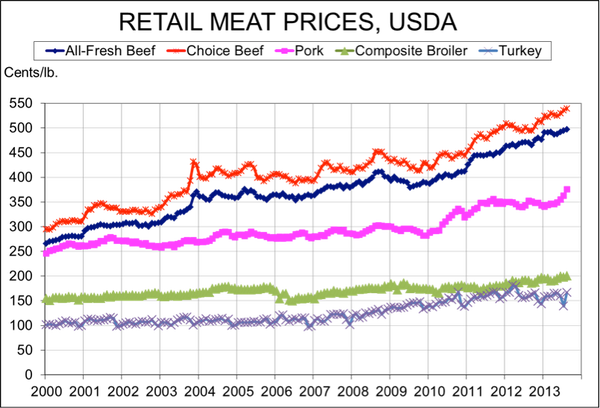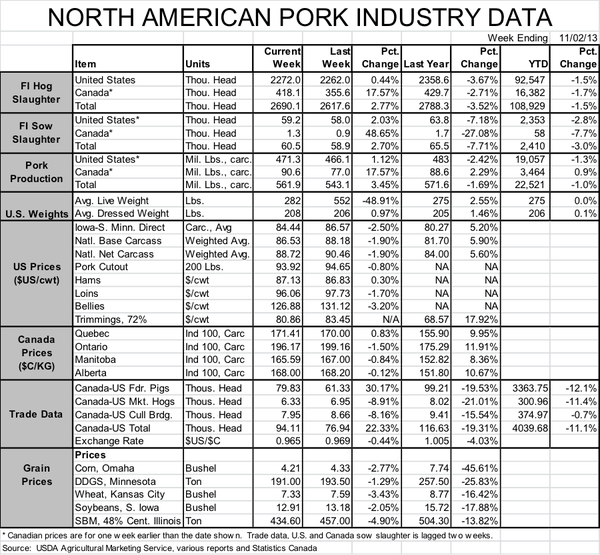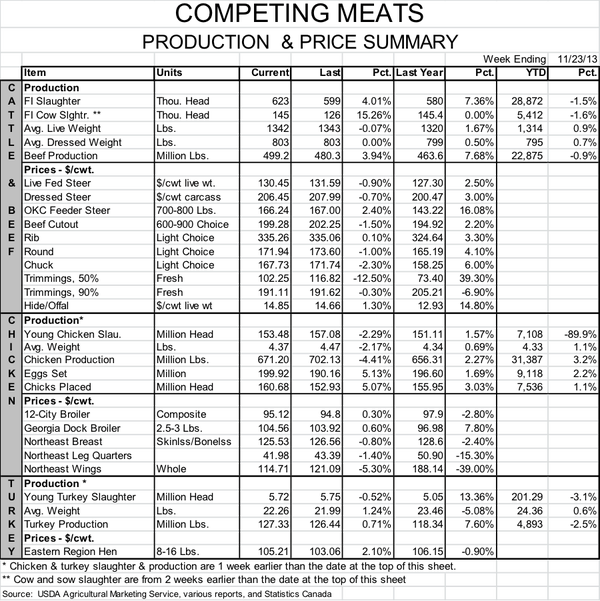PEDV May Thwart Pork’s Chance to Grab Beef Market Share
November 4, 2013

A victim of the ongoing porcine epidemic diarrhea (PED) virus situation may well be the passing of a golden strategic opportunity for the pork industry to gain market share from beef. These kinds of opportunities do not come often. I can’t say the opportunity will be squandered because its loss will have nothing to do with poor, misguided or incompetent efforts. It may just happen. And that is frustrating and sad.
The opportunity has availed itself due to the long-standing adjustment of the beef industry to higher feed costs and then an epic battle against two years of drought. The result is the smallest beef cow herd and calf crops in memory with cattle numbers falling enough that production levels can no longer be maintained just by making them bigger at harvest. Add production difficulties to a rebound in U.S. beef exports and you get the smallest level of domestic beef availability-disappearance-consumption (25.536 billion pounds, carcass weight) since 1995. Factor in a larger U.S. population and per capita availability-disappearance-consumption will, at 56.5 pounds retail weight, this year be the lowest since 1959. I was 2 years old the last time Americans ate this little beef!!!!
And what’s more, the numbers will get SMALLER over the next two years as cows are retained instead of slaughtered and as heifers are pulled from market flows to add to the breeding herd. The Livestock Marketing Information Center in Denver predicts per capita availability-disappearance-consumption to be 53.3 and 51.9 pounds per person in 2014 and 2015, respectively. Those figures are 5.6% and 2.7% lower than the previous year.
Why is this important? Because Americans will still want to eat animal protein if they can afford it. Enter lower-cost pork and chicken. I believe Americans have proven over and over that they have a strong preference for beef because they have generally been willing to pay so much for it. As can be seen in Figure 1, beef prices have always been significantly higher than the prices of other animal proteins, and the gap has generally grown in recent years.

But there is this small item of a budget constraint. We know that the concept is a fanciful as the Easter Bunny and Santa Claus to the federal government but it is very real indeed to most families. Spreading that budget over enough pounds of product to satisfy a family is more and more challenging – just as I predicted it would be when subsidized and mandated usage of corn for ethanol increased total corn demand faster than corn supply could be increased. The droughts of 2011 and 2012 have exacerbated the problem for the beef industry to the point that lower-cost pork and poultry have a great opportunity to take market share over the next two years. Whether they can defend that market share in the long run would still be a challenge but capturing it must come first.
Enter PEDV. Before October, it appeared that pig numbers would grow sharply in 2014. Profit forecasts and some pent-up expansion fever were in place. USDA’s September Hogs and Pigs report said that supplies were growing at a faster rate than anyone expected, and the PED virus was not having as big of an impact as I (and many others) had feared.
But supplies since Oct. 1 have remained well below expected levels. It seems that news comes daily of new sow units that are breaking with the disease that is costing roughly 2.5 pigs per sow in annual output. Most fear that the losses will get larger as temperatures fall
I wish I knew just how many pigs we are losing each week. My best guess is that we are taking a 2 to 4% hit on supplies for Q2 of 2014. That would put numbers near or just below those of 2013, meaning hog and pork prices will remain strong. Given low and falling feed costs, that is great news from a profit standpoint. But it also means that the pricing advantage we had expected next year in the meat case and on restaurant menus will be much smaller, and may not materialize at all.
Don’t get me wrong. Profits are nice and I know producers everywhere need a good year or two of healing up. But a once-in-a-generation opportunity to impact people’s buying habits is a large price to pay for a year or two of strong profits.
The incentive to stop PED virus is already strong. Producers, veterinarians and scientists are doing everything they can to accomplish that. They need no more reason to work hard but just in case, let’s remember this golden opportunity at our doorstep. It will not be gone quickly but neither will it tarry long.


About the Author(s)
You May Also Like





